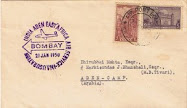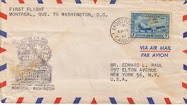Saturday, May 24, 2008
Aviation First Day Covers
http://www.flickr.com/photos/22512826@N08/sets/72157605228228012/
Click on the link or paste on a browser.
Thursday, May 22, 2008
Airmail Stamps
The honor of issuing the first airmail stamp goes to Italy.

An existing Express Delivery stamp was overprinted and issued on 22nd May, 1917 for the first official airmail between Rome and Turin.
The first airmail stamps were issued in the US on 15th May, 1918 when the first official airmail between Washington, Philadelphia and New York was inaugurated. The basic rate per ounce for transmission by air was 14c "air fee" and 10c for the special delivery fee. For this purpose a 24c stamp depicting the Curtiss Jenny was issued. Since this was a new service the stamp was issued in a distinguishing bi-colored format, in the patriotic colors - red, white and blue.
 This stamp has become one of the most famous US stamps as one sheet of 100 stamps was sold with the center inverted and is well known as the "inverted jenny". A single mint (unused) stamps was sold for $977,500 in an auction on 14 November 2007.
This stamp has become one of the most famous US stamps as one sheet of 100 stamps was sold with the center inverted and is well known as the "inverted jenny". A single mint (unused) stamps was sold for $977,500 in an auction on 14 November 2007.As the airmail fee dropped, a 16c denomination was issued on 11 July 1918 and a 6c stamp was issued in December that year when the special delivery fee was dropped.
Issue of airmail stamps became the norm from then on as countries started airmail services within their countries and then to countries round the globe. Not all stamps had any "aviation" motif on them but all bore the word "airmail" "correo areo" "par avion", 'postes aerienne" or similar inscriptions in the language of origin. In most cases all mail sent by air had necessarily to be franked with airmail stamps. Airmail etiquettes (labels) were also issued but letters could be also be inscribed "by airmail" or equivalent as use of labels was not compulsory. To start with Some countries just overprinted existing stamps with the word airmail or a plane.
A few stamps overprinted with airplanes for use on airmail letters.

Monday, May 19, 2008
A few first flight covers

BOAC Comet Jetliner Service between London and Colombo via Rome, Beirut, Karachi & Bombay. A stop was introduced at Bahrain on the return flight.
A cover flown from Bombay to Colombo on the first flight.
BOAC had standard covers with a printed cachet for all flights with appropriate changes.

Lufthansa introduced Boeing 707 on their LH 562 route from Frankfurt to Accra via Abidjan in April 1978.
A special printed cover flown on the first flight from Abidjan to Accra. A special hand stamp was applied to mails flown on the first flight.

Air New Zealand introduced DC 10 aircraft on their service to the US in 1973.
A cover flown from Aucklank to Los Angeles on the first flight on 2nd April, 1973. The NZ post office postmarked all covers flown on the FF with a special postmark.
Alitalia inaugurated their Rome - Bombay air service on 4th March, 1959. A special postmark was used to postmark mail flown from Rome. A special hand stamp was applied to mails flown on the first flifht from Bombay to Rome.


Japan Airlines inaugurated a regular service between Tokyo and Bombay on 3rd July 1972. Attractive covers were specially printed for the first flight. Covers flown on the first flight from Bombay received a special round hand stamp.


Thursday, May 15, 2008
First Flight Covers (FFCs)
A weekly airmail service was started between Karachi & Bombay on 23rd January, 1920. The return flight was on 24th January, 1920. DH 10 planes of the No.97 Sqdn. RAF were used. A surcharge of 8as was charged for each letter.
A cover flown on the first return flight Bombay to Karachi. A special postmark was used for all mails carried on the Airpost.
FFCs may have special markings, hand stamps, postmarks, labels etc. The one important feature of a FFC is that they are always back stamped at the place of arrival proving that they were actually flown. FFCs are usually collected in pairs i.e. on both the outward and inward flight. Early FFCs were sometimes signed by the pilots. In the
Reverse of the above cover showing the Karachi arrival stamp of 25 JAN 20.
As first flight covers became popular both airlines and postal administrations started issuing special covers and special postmarks etc. Airlines started issuing first flight covers when new aircraft were introduced even though the routes were ones on which they flew earlier.
Sometimes postal administrations issued special stamps for a first flight which were valid only on the first flight and withdrawn after that. India issued a 12as stamp to commemorate the first Air India flight to London on 8th June 1948. The stamp was valid for postage only on covers flown on the first flight. The Air India aircraft named the Rajput Princess from Bombay flew to London with stops at Cairo & Geneva reaching London on 9th June, 1948. Covers were flown on all the stages i.e. Bombay to Cairo, Geneva, London, Cairo to Geneva & London & Geneva to London.
Monday, May 12, 2008

From earliest times man dreamt of imitating birds and soaring aloft. Ancient

The new machines could be advantageously used for speedy transit of mail. But before mail could be transported regularly by air the system of airmail had to prove its worth.
Though some mail was unofficially carried earlier – the world’s first official airmail was flown in
World War I, gave the impetus the aeroplane industry required. European countries used aircraft first for transmission of official dispatches and later as weapons of war. As the war progressed so did the quality of aircraft improve considerably.
All over the world experimental flights were being undertaken to explore the feasibility of regular airmails. In December,1918 Handley-Page aircraft was flown from
Airmail developments were also taking place in
The England-India route, vital to British Communication as it passed through
There were days when experimental flights were being made all over the world. Almost all countries had some sort of air service experiments during the 20s and even in the 30s. The experimental airmails soon progressed to regular airmails. During the 1920s many airline companies were formed, and by the 30s almost all countries could boast of an airline company and some sort of regular air service.
World War II brought even more development and by the end of the War the Industry had developed to a very great extent. Larger aircraft with bigger capacity and range were being built. The jet was the next development bringing Countries closer and now we are in the era of Supersonic travel. Soon, interplanetary travel will be an everyday affair.
At all stages mail has been carried which are souvenirs not only of flights but also of the adventurous spirit of man. Flight covers are a piece of history – aviation as well as postal. These covers are records of an historical period. They tell the story of the development of aviation and airmail from the early days of adventure and romance of flying to the safe, comfortable, almost plebian air travel of today. Their appeal is certainly far more than a stamp that may not have seen any postal service as in the case of a mint stamp. The First Flight Cover has a story to tell unlike an ordinary used cover with a stamp. It was actually flown in a plane, on a first flight or a special flight, on a route never before flown by an aircraft. Today we take airmail for granted. But the pioneer or first flight covers are the true forerunners of today’s most used postal service.
After World War II, Airline Companies realizing the interest of collector’s, prepared first flight covers in attractive designs with cachets. Air India First Flight covers are very attractive as are those of most airlines today. Though these covers are souvenirs prepared for collectors their appeal remains. Certainly they have much more to say than the specially prepared First Day Covers. They are souvenirs of a new route by an Airline or of a new plane. When the Boeing 747 ‘Jumbo’ was introduced all airlines carried mails on the inaugural flights though on old routes. But the covers are pieces of historical interest – the history of a new aeroplane service.
Today the accent is on collecting postal history items and its popularity is growing. What branch of postal history could be more fascinating than the story of man’s conquest of the air and the speedy delivery of mails to hours or day instead of weeks or months?
Flight covers can add flavor to a country stamp collection. Flown covers representative of the airmails of your country can enrich and make your collection postally and historically complete.
The investment potential of flight covers is very great. The Pioneer airmen carried few pieces of mail on early flights. Even later the number of covers carried by airlines are very much smaller compared to the number of First Day Covers sold on the first day of issue of a new stamp. As more and more people turn to postal history the prices of early and scarcer airmail covers are bound to go up. Why not start now before its too late.
In future post I'll deal with various topics relating to aero-philately. Keep checking
Sunday, May 11, 2008
AERO-PHILATELY
I am an aero-philatelist. I find that there are very few website devoted to this branch of philately so I thought blog which will help popularize this branch of philately.
Aero-philately is a branch of philately specializing in the collection of philatelic items relating to airmails. Aero-philatelists study the development of airmails and tell the story of the development of aviation through stamps, covers postmarks etc.
The scope of aerophilately includes:
- airmail postage stamps, both official and unofficial
- stamps depicting various aspect of "aviation" eg. aircraft, airlines, airports etc.
- other types of labels (such as airmail etiquettes)
- all kinds of mail transmitted by air
- postal markings related to air transport
- first flights and other "special" flights covers
- rates and routes
- mail recovered from aircraft accidents and other incidents (crash covers)
Besides the study of airmail transport by fixed-wing aircraft, the fields of balloon mail, helicopter mail, dirigible mail, zeppelin mail, missile mail, and rocket mail are active subspecialties. Astrophilately, the study of mail in space, is a related area.
I'll explain the various nuances in future posts, with pictures etc.
Please contact me if you are a fellow enthusiast or want to know more about aero-philately.
















